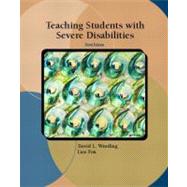
| Initial Considerations | |
| Students with Severe Disabilities: Definitions, Descriptions, Characteristics, and Potential | |
| Philosophy and Best Practices for Educating Students with Severe Disabilities | |
| Collaboration among Professionals and Paraprofessionals | |
| Parents, Families, and Cultural Issues | |
| Preparing to Teach | |
| Planning Instructional Programs for Students with Severe Disabilities | |
| Conducting Assessments to Determine Instructional Needs | |
| General Instructional Procedures | |
| Teaching Students to Acquire New Skills | |
| Teaching Skills for Generalization and Maintenance | |
| Evaluating Student Progress | |
| Creating Inclusive Educational Environments | |
| Specific Instructional and Management Procedures | |
| Teaching Communication Skills | |
| Providing Behavioral Supports to Improve Challenging Behavior | |
| Managing Sensory and Motor Systems | |
| Providing Support for Health and Medical Needs | |
| Teaching Personal Care Skills | |
| Teaching Leisure and Recreational Skills | |
| Teaching Appropriate Academic Skills | |
| Teaching Community and Domestic Skills | |
| Special Considerations | |
| Using Technology to Enhance Teaching and Learning | |
| Meeting the Needs of Young Children | |
| Transition Planning and Adult Issues | |
| Table of Contents provided by Publisher. All Rights Reserved. |
The New copy of this book will include any supplemental materials advertised. Please check the title of the book to determine if it should include any access cards, study guides, lab manuals, CDs, etc.
The Used, Rental and eBook copies of this book are not guaranteed to include any supplemental materials. Typically, only the book itself is included. This is true even if the title states it includes any access cards, study guides, lab manuals, CDs, etc.